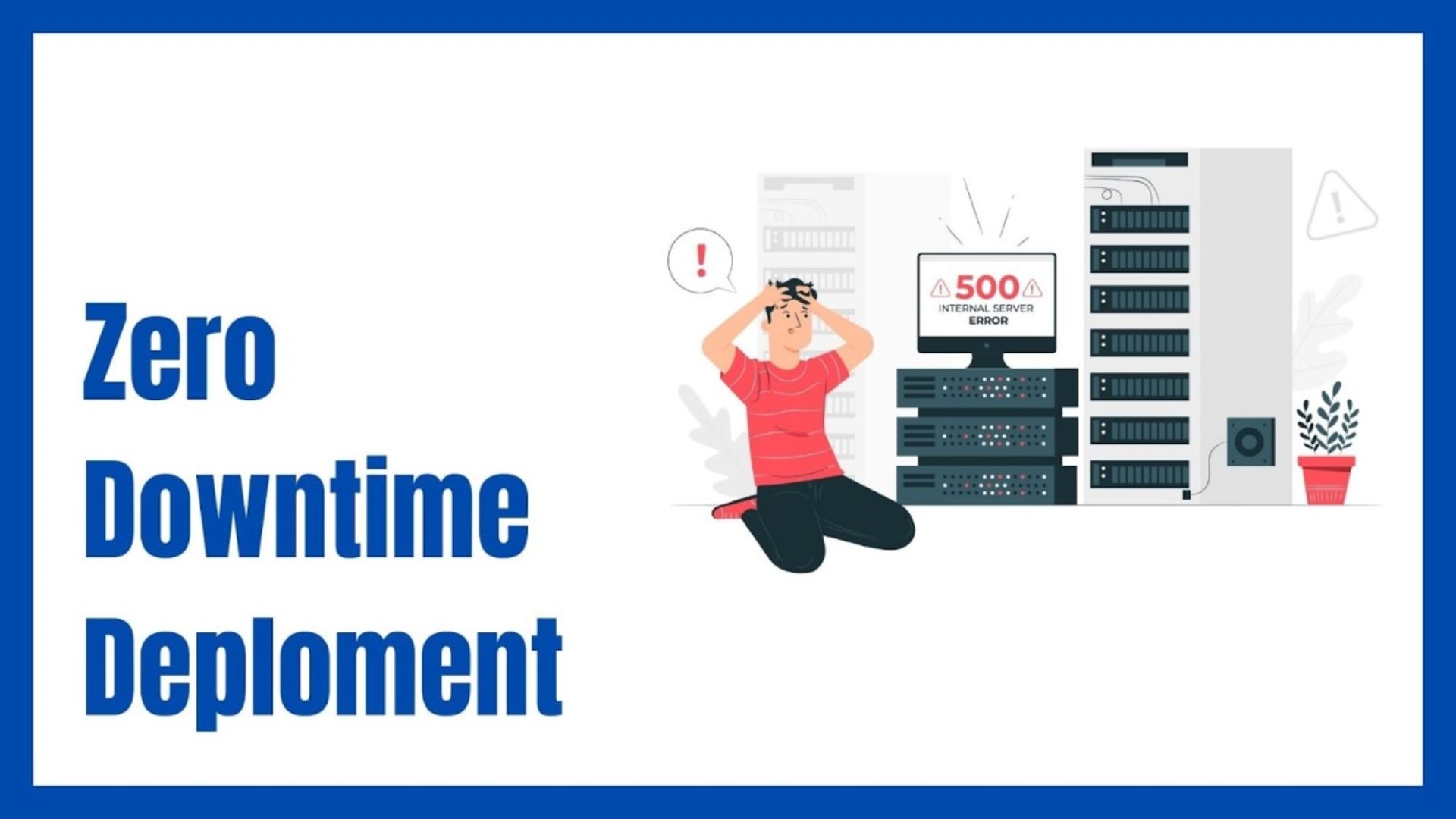Achieving timely deployment is the ultimate goal of software updates. Zero downtime deployments are the art of seamlessly rolling out changes or updates to a live system without causing disruptions or downtime making the deployment process more efficient. Imagine a world where businesses can update their software, add new features, or fix bugs, all while users continue to enjoy uninterrupted service. Sounds like a dream, right? Well, with zero-downtime deployment, it becomes a reality.
So, why does zero-downtime deployment(ZDD) matter? For businesses, ZDD is the secret weapon that keeps the wheels turning, the cash flowing, and the customers cheering. Imagine the horror of service disruptions causing a revenue nosedive or a furious mob of users storming your virtual gates. No, thank you! With ZDD, businesses can defy the odds and keep their customers happy.
According to a survey conducted by the DevOps Research and Assessment (DORA) State of DevOps Report 2017, organizations that adopted CI/CD practices achieved notable benefits compared to those that did not. The best teams deploy 973 times more frequently and have lead times 6750 times faster when compared to low performers.
We will dive deeper into the intricacies of ZDD, exploring its benefits, challenges, and best practices. Join us on this journey as we uncover the secrets to achieving uninterrupted software updates and unlocking a world of unparalleled user experiences.
Understanding Zero-Downtime Deployment
A zero-downtime deployment is an approach of releasing software that guarantees that a service or application will not go offline at any point throughout the rollout process. It’s the process of making adjustments or updates to a running system without incurring any downtime for its users and closely related to DevOps development.
The enhanced user experience is only the tip of the iceberg regarding the numerous benefits of ZDD. Users can continue using the application without any setbacks when service disruptions have been resolved. The result is happier users, and more active users.
Furthermore, income is directly impacted by a ZDD strategy. This way, companies won’t have to worry about losing money because of downtime. Businesses can avoid potential revenue losses that occur during downtime. Uninterrupted availability ensures that customers can access and use the service without hindrance, leading to continued transactions, conversions, and sales.
In addition to financial gains, ZDD contributes to an enhanced reputation. Businesses that consistently provide uninterrupted services earn a reputation for reliability and professionalism. This positive reputation attracts new customers and retains existing ones, contributing to long-term success.
However, achieving zero-downtime deployment comes with its fair share of challenges. One of the main challenges is the technical complexity involved. Coordinating the deployment process, managing data migrations, and ensuring compatibility across systems can be intricate and requires careful planning and execution.
Cost implications are another consideration. Implementing the necessary infrastructure, automation tools, and monitoring systems to support ZDD can involve upfront investments and ongoing maintenance expenses. Organizations must weigh the costs against the potential benefits and align them with their business objectives.
Continuous Deployment: A Key to Zero-Downtime Deployment

Continuous deployment is a strategy for automatically pushing the software into the production environment. Continuous Deployment strategies streamline the software release process by automatically building and testing the software. CD allows organizations and teams to push releases quickly and more frequently.
Continuous deployment is crucial in achieving ZDD by automating the release process and automatic deployment. Through automation, the risk of disruptions is mitigated to enable a seamless transition from one version of software to another. This ensures that updates are rolled out gradually without causing users any downtime or service interruptions.
Continuous deployment brings several benefits to software development teams and businesses. Continuous deployment facilitates agile and swift software updates, resulting in faster release cycles. Implementing agile methodologies enables enterprises to react promptly to market requirements and customer input.
Every code change goes through an automated build and testing process with continuous deployment. This rigorous testing helps identify issues early on, ensuring that only high-quality, thoroughly tested code is deployed. Continuous deployment encourages cross-functional collaboration among development, operations, and quality assurance teams. This collaboration leads to faster feedback loops, improved communication, and a more efficient workflow.
Components of continuous deployment include:
- Continuous Integration (CI): CI involves integrating code changes into a shared repository frequently. It ensures that each code change is automatically tested and verified to maintain code integrity and identify integration issues early on.
- Continuous Delivery (CD): CD focuses on automating the delivery process, including building, testing, and deploying software. It ensures that the application is always in a deployable state, ready to be released to production.
- Infrastructure as Code (IaC): IaC treats infrastructure provisioning and configuration as code. It allows infrastructure to be defined, managed, and deployed through code, ensuring consistency and reproducibility across environments.
Strategies for Achieving Zero-Downtime Deployment
When achieving zero-downtime deployment, organizations can use several deployment strategies. Let’s explore a few popular approaches.
#1 Blue-Green Deployment
Blue-Green Deployments involve running two identical environments in production, referred to as blue and green. The live traffic is routed to one environment while the other remains idle. The new version of the software is deployed and tested in the idle environment.
#2 Canary Deployment
Canary Deployment involves gradually rolling out new software updates to a subset of users or servers while leaving the rest on the previous version. Canary deployments allow real-time monitoring and observation of the new release’s behavior and performance. The deployment is expanded to the entire user base or servers if the new version proves stable and reliable.
#3 Rolling Deployment
Rolling Deployment involves gradually updating the software across servers or instances in a sequential manner. One instance at a time is taken offline, updated, tested, and brought back online before moving on to the next instance. This process continues until all instances have been updated.
#3 A/B Deployment
A/B Deployment involves concurrently running two versions, A and B, in production. The incoming traffic is split between the two versions, with some users directed to version A and the rest to version B. This allows for comparing the performance, user experience, or other metrics between the two versions.
Tools and Technologies for Zero-Downtime Deployments
Organizations can leverage various tools and technologies that automate and streamline the deployment process to achieve ZDD. Let’s briefly introduce some of the key ones.
Version Control Systems
Version control systems such as Git and Subversion are crucial for source code maintenance and change tracking. By providing a centralized code repository, they boost team collaboration and streamline deployment.
Continuous Integration and Continuous Deployment Tools
The software development lifecycle (SDLC) is streamlined with the use of Continuous Integration (CI) and Continuous Deployment (CD) tools, which automate the build, test, and deployment processes.
- Jenkins is a CI/CD platform that is open-source and free of cost. It supports seamless integration with an extensive range of add-ons and connections.
- Travis CI’s infrastructure for continuous integration and deployment was designed with a focus on GitHub projects and is based on cloud. The setup process is straightforward and it has extensive support for various programming languages and frameworks.
- CircleCI is a cloud-based platform for continuous integration and continuous delivery. The software is designed to seamlessly integrate with widely used version control systems and facilitate concurrent testing.
- The GitLab platform incorporates GitLab CI/CD as a fundamental functionality. It provides a full set of tools for version management, continuous integration, and automated deployment.
Infrastructure as Code Tools
Infrastructure as Code (IaC) tools allow organizations to manage programmatically and provision infrastructure resources, ensuring consistency and reproducibility across different environments. Organizations use Infrastructure as Code (IaC) solutions to manage and deploy infrastructure resources programmatically, resulting in consistent and reproducible results across environments. Popluar IaC tools are as follows:
- The open-source IaC utility Terraform facilitates provisioning and administration of infrastructure across many cloud providers and infrastructure platforms.
- To configure and deploy an infrastructure, you can use Ansible, an agentless automation tool. It’s based on a declarative language that simplifies and streamlines the management of infrastructure as code.
- Chef is an infrastructure provisioning, configuration, and deployment automation program used for configuration management. The framework defines infrastructure as code using the Ruby programming language.
- Puppet is a configuration management solution that offers a declarative language to define and administer infrastructure resources. Provisioning, setup, and orchestration are just some of the processes that may be automated.
Best Practices for Zero-Downtime Deployment
To achieve successful zero-downtime deployment, organizations should adhere to several best practices that ensure a smooth and reliable release process. Let’s discuss some key practices.
#1 Proper Planning and Coordination
Proper planning and coordination among teams are paramount to achieving zero-downtime deployment. Planning includes considering potential risks, defining rollback strategies, and conducting thorough testing before deploying to production. Effective coordination ensures that everyone involved is aligned, aware of their responsibilities, and working towards the same goal.
#2 Monitoring and Logging
Monitoring and logging play a critical role during deployments by providing real-time visibility into the system’s health and performance. It is crucial to establish comprehensive monitoring mechanisms that track key metrics and alert teams in case of anomalies or issues. Logging enables capturing detailed information about the deployment process, making it easier to identify and diagnose any problems that arise.
#3 Automated Testing
Automated testing is essential for ensuring the stability and reliability of deployments. Implementing a robust test suite that includes unit tests, integration tests, and end-to-end tests helps catch bugs, compatibility issues, and other errors early in the release process. Automation accelerates the testing phase, reduces human error, and provides faster feedback on the quality of the deployment.
#4 Effective Communication
Effective communication is vital for achieving successful ZDD. Team members and stakeholders must have clear lines of communication to discuss plans, address concerns, and share progress updates.
Conclusion
Zero-downtime deployment is essential for businesses and users alike. It ensures uninterrupted service availability, resulting in an improved user experience, increased customer satisfaction, and retention. It also leads to increased revenue as transactions, conversions, and sales continue without interruption. Continuous deployment, which includes practices like ZDD, enables businesses to respond rapidly to market demands, deliver new features quickly, and stay competitive in the dynamic digital landscape.
By adopting the strategies, tools, and best practices mentioned above, organizations can minimize downtime, mitigate risks, and achieve successful zero-downtime deployments. These practices not only ensure the smooth release of software updates but also contribute to overall system stability, scalability, and maintainability. Encouraging the adoption of these best practices will lead to more efficient and reliable deployments, benefiting both businesses and users.
If you enjoyed this, be sure to check out our other DevOps articles.






